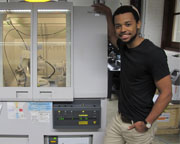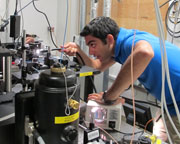E3S REU Participants and Projects: 2015
 Undergraduate Researcher: Joubel Boco
Undergraduate Researcher: Joubel Boco
Major: Electrical Engineering
Home Institution: Prince George’s Community College
Research Project: Molecular Dynamics Study of CdSe as Buffer Layer in CdTe/CdS Solar Cell
Faculty Advisor: Prof. David Zubia
Postdoctoral Mentor: Dr. Jose Chavez
Hosting Organization: Electrical and Computer Engineering Department, UTEP
Project Abstract: Cadmium selenide is a II-IV semiconductor compound with properties that are ideal for photovoltaic applications. This project explores the use of CdSe as buffer layer in CdTe/CdS solar cells. A comprehensive study of CdSe was conducted using molecular dynamics simulations. The simulations consisted of the growth of CdSe by homoepitaxy (CdSe/CdSe) and heteroepitaxy (CdSe/CdS). The best growth conditions of CdSe were also used to deposit CdSeTe with varying selenium composition on a CdS substrate. The results show that CdSe has the lowest dislocation density. Project poster
Undergraduate Researcher: Annette Brocks
Major: Chemistry
Home Institution: University of Delaware
Research Project: Synthesis of a Redox-Triggered Compressible Macrocycle for Use in Squitches
Faculty Advisor: Prof. Timothy M. SwagerGraduate Student Mentor: Wen Jie Ong
Hosting Organization: Chemistry Department, MIT
Undergraduate Researcher: Andrew Cook
 Major: Physics
Major: Physics
Home Institution: University of Maryland, Baltimore County
Research Project: Thermoelectric Properties of Cadmium Oxide and Cadmium Zinc Oxide
Faculty Advisor: Prof. Junqiao Wu
Postdoctoral Mentor: Dr. Bivas Saha
Hosting Organization: Materials Science & Engineering Department, UC Berkeley
Project Abstract: The thermoelectric properties of the semiconducting oxide thin films cadmium oxide (CdO) and rocksalt-phase cadmium zinc oxide (CdxZn1-xO) with x = 0.75 Cd concentration are characterized both computationally with the software Quantum Espresso and experimentally through the 3-Ω method. These methods determine the dispersion relation and specific heat, and lay the groundwork for measuring the thermal conductivity. Coupled with the high electron concentration, mobility, and infrared transmittance inProject posternt in CdO films, this suggests viable heat transfer and dissipation properties appropriate for energy-efficient applications to transparent conductors often seen in photovoltaics. Project poster
Undergraduate Researcher: Azzedin Jackson

Major: Materials Science and Engineering
Home Institution: Purdue University
Research Project: X-Ray Diffraction Characterization of Lead Zirconate Thin Films
Faculty Advisor: Prof. Sayeef Salahuddin
Graduate Student Mentor: Korok Chaterjee
Hosting Organization: Electrical Engineering and Computer Sciences Department, UC Berkeley
Project Abstract: It has been demonstrated that ferroelectric insulators exhibit negative capacitance, which could lead to the operation of FETs at lower voltages. However, while the ferroelectric capacitor reduces the total amount of power needed to operate the FET, some of the power used in the FET operation is necessary to switch off the ferroelectric insulating layer. One approach to removing the need for this extra voltage is to use an antiferroelectric insulating layer. To begin to better understand antiferroelectrics for this potential application, lead zirconate (PZO), an antiferroelectric, was grown on different oxide substrates with conductive strontium ruthenate (SRO) as a bottom electrode and examined via X-Ray Diffraction (XRD). We found that the PZO-SRO grows well on STO, DSO, GSO, and that the c lattice parameter of the PZO layer decreases as substrate lattice parameter increases. Project poster

Undergraduate Researcher: Donato Kava
Major: Electrical Engineering
Home Institution: University of Texas at El Paso
Research Project: Characterization of Contact Adhesion in MEM Relays
Faculty Advisor: Prof. Tsu-Jae King Liu
Postdoctoral Mentor: Dr. Alexis Peschot
Hosting Organization: Electrical Engineering and Computer Sciences Department, UC Berkeley
Project Abstract: Power consumption limits the range of applications for computing devices today. In the future, electronic switches that operate with superior energy efficiency to the metal-oxide-semiconductor field-effect transistor (MOSFET) will be needed to enable the Internet of Everything. Micro/Nano-Electro-Mechanical (M/NEM) switches (relays) are promising in this regard, because they can be operated with voltages less than 10 mV, wProject posteras MOSFETs today are operated with ~1 V. In order for integrated systems of mechanical switches to operate reliably, however, contact adhesion must be minimized in a controllable manner. Toward this goal, the influence of relay operating conditions on contact adhesion is experimentally studied. Project poster
Undergraduate Researcher: Allison Perna

Major: Materials Science and Engineering
Home Institution: Carnegie Mellon University
Research Project: Dopant Calibration for Tunnel Field Effect Transistors
Faculty Advisors: Prof. Judy Hoyt and Prof. Dmitri Antoniadis
Graduate Student Mentor: Winston Chern
Hosting Organization: Electrical Engineering and Computer Science Department, MIT
Project: Click Project poster
Undergraduate Researcher: Sarah Stevenson

Major: Physics/Astrophysics
Home Institution: Williams College
Research Project: Second Harmonic Generation and Magnetic Contrast versus Laser Intensity for Materials of Interest in Spin Hall Effect Spin Current Generation
Faculty Advisor: Prof. Jeffrey Bokor
Graduate Student Mentor: Akshay Pattabi
Hosting Organization: Electrical Engineering and Computer Sciences Department, UC Berkeley
Project Abstract: The spin-Hall effect (SHE) is the generation of a spin current transverse to an applied charge current in materials with high spin-orbit coupling. This could potentially be used to exert useful magnetic torques in magnetic devices. Magnetization-induced second harmonic generation (MSHG) offers a direct method for examining spin accumulation due to the SHE at the surfaces and interfaces of normal metals. This project examines second harmonic intensity as a function of laser intensity for different spin-Hall metals like Au, Pt, Ta, and a Ta/Pt bilayer. The magnetic asymmetry signal, indicative of the magnitude of spin accumulation, is also investigated as a function of laser intensity in 10 nm Pt. Project poster
Undergraduate Researcher: Ava Tan

Major: Physics
Home Institution: Cornell University
Research Project: Spray Pyrolyzed High-k Dielectrics for Thin Film Transistor Applications
Faculty Advisor: Prof. Vivek Subramanian
Graduate Student Mentor: Will Scheideler
Hosting Organization: Electrical Engineering and Computer Sciences Department, UC Berkeley
Project Abstract: High-κ metal oxides are being extensively investigated for use as viable gate dielectric materials to replace silicon dioxide (SiO2) in thin film transistors. Composite materials such as lanthanum-doped zirconia (LaxZr1-xOy) are attractive options to explore, as a combination of materials with individually favorable qualities can yield dielectrics with large bandgaps and high dielectric constants. Alloyed dielectrics, remaining amorphous at high temperatures, also tend to be more resistant to crystallization, which can potentially reduce leakage currents when used in fabricated devices. Lanthanum, which has a slightly larger atomic radius than zirconium, acts as a deterrent for crystallization in zirconia films by inducing steric hindrance effects during film formation. Lanthanum-doped zirconia (LZO) films with varying lanthanum concentrations of 0, 2, 5, 10, and 20% were grown using an alternative solution-processing technique, spray pyrolysis, as a means of investigating a versatile, highly repeatable manufacturing mechanism to replace traditional vacuum-based techniques. The resulting films have high dielectric constants (~13-14), high breakdown fields (~3-4 MV/cm), and leakage current densities as low as 10-8 A/cm2. Finally, metal oxide thin film transistors (TFTs) incorporating these dielectric films are fabricated and assessed for their electrical performance, as well as their potential for large-scale applications. Project poster
Undergraduate Researcher: James Townley

Major: Materials Science and Engineering
Home Institution: University of Pennsylvania
Research Project: Three-Terminal Carbon Nanotube Nano-Electro-Mechanical Relays
Faculty Advisor: Prof. H.-S. Philip Wong
Postdoctoral Mentor: Dr. Ji Cao
Hosting Organization: Electrical Engineering Department, Stanford University
Project Abstract: Design and fabrication of new low-power computing systems are of great interest and importance. By applying low van der Waals materials, carbon nanotube (CNT) relays are promising nano-electro-mechanical (NEM) devices due to CNTs’ low mass, small dimension, high Young’s modulus, and high current density. The CNT clamped-clamped relays have been fabricated using a bottom-up integration scheme, wProject poster single-walled metallic CNTs are self-aligned into electron-beam resist trenches using ac-dielectrophoresis (DEP). This research investigates a three-terminal CNT relay fabrication process and electrical measurements for use in low-power computing. Project poster
Undergraduate Researcher: Zeyan Xu
Major: Physics
Home Institution: University of Texas at Dallas
Research Project: Radiation Pattern and Scattering Properties of Optical Antennas
 Faculty Advisor: Prof. Eli Yablonovitch
Faculty Advisor: Prof. Eli Yablonovitch
Graduate Student Mentor: Kevin Messer
Hosting Organization: Electrical Engineering and Computer Sciences Department, UC Berkeley
Project Abstract: When light emitting devices (e.g. LEDs) are coupled to optical antennas of the same resonance frequency, their spontaneous emission rate can be enhanced drastically. The ultimate goal is to have the rate of spontaneous emission faster than the stimulated emission so that the LEDs would be as fast as lasers and enable us to achieve energy efficient interconnects for on-chip communication. In this project, we theoretically and experimentally measured the far-field radiation pattern and the light scattering spectrum of a series of as-fabricated optical antennas. These measurements enabled us to characterize and better understand the fundamental behaviors of optical antennas. Project poster
Undergraduate Researcher: Siavash Zamani

Major: Physics
Home Institution: Pennsylvania State University
Research Project: Dark-Field Microscopy on Optical Antennas at Near-Infrared Frequencies
Faculty Advisor: Prof. Ming C. Wu
Graduate Student Mentor: Seth Fortuna
Hosting Organization: Electrical Engineering and Computer Sciences Department, UC Berkeley
Project Abstract: Optical interconnects that contain nanoLEDs coupled with optical antennas have been proven to be more energy efficient than traditional metal interconnects. At near-infrared (IR) frequencies, the waveguides that are coupled into the optical interconnect are transparent and tProject posterfore have lower attenuation than other frequencies. An experiment was setup to measure the resonance frequencies of cavity-backed slot antennas at near IR. This measurement had not been done with the current equipment available to the Berkeley Photonics team, and it was not known if the current InGaAsP detector could measure resonance at near-IR frequencies. Project poster
